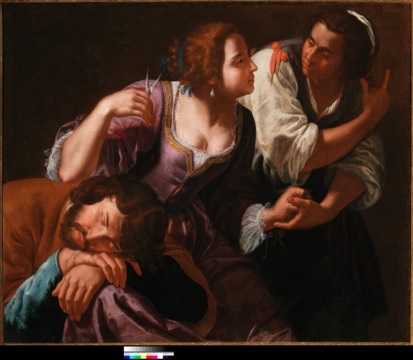
Artemisia Gentileschi: the spirit of Caesar in the soul of a woman
24/05/2023
A new exhibition at Gallerie d’Italia – Napoli celebrates the distinctive output of a successful Renaissance artist who imbued her female subjects with strength and courage
“Gentileschi was a fine painter, but we want to avoid underlining her exceptionality. We prefer to look at her alongside her peers in Naples at that time” – Giuseppe Porzio, co-curator, Artemisia Gentileschi in Naples
Before she had even turned 20, Artemisia Gentileschi’s father Orazio, also a painter, penned a letter to a prospective patron in Florence, recommending her services. “My daughter has been painting for three years,” he wrote, “and she’s already capable of such works that many principal masters of this profession never arrive at.”
Orazio’s words undoubtedly came with a modicum of paternal bias and pride. However, so distinctive was the imagery Artemisia created throughout her career, and in such high regard is she held by curators and critics today, her father’s words seem to have been rooted in truth.
Born in Rome in 1593, she led an eventful, peripatetic life that included lengthy spells living and working in Florence, Venice, London and Naples. The years she spent in the last of those great cities are the subject of a new exhibition, Artemisia Gentileschi in Naples.
Featuring approximately 50 works, it is being staged, appropriately enough, at Gallerie d’Italia – Napoli, the museum of Intesa Sanpaolo banking group in Naples.
“The time that the artist spent in other places is perhaps better known than the time she spent in this city,” says Antonio Ernesto Denunzio, Deputy Director of Gallerie d’Italia – Napoli and co-curator of the exhibition. “However, as we found in putting this show together, Artemisia’s Neapolitan years are every bit as interesting.”
Apart from a brief spell in London between 1638 and 1640, Gentileschi lived in Naples uninterrupted from 1630 until her death some time in the mid-1650s (the precise date of her passing isn’t recorded). She ran a successful, independent workshop – a rare feat for a female artist at the time – and maintained connections with princes and other important patrons across Europe.
Artemisia Gentileschi in Naples features such standout paintings from her Neapolitan years as Saint Catherine of Alexandria (from the collection of Nationalmuseum in Stockholm) and Judith and her Maidservant with the Head of Holofernes (from the collection of the National Museum in Oslo).
Giuseppe Porzio, the exhibition’s co-curator, says: “One thing that made Artemisia special as a painter was the heroines she made of her female subjects – whom she invested with strength, courage.”
These subjects included the biblical figure of Delilah in the painting Samson and Delilah, which forms part of Intesa Sanpaolo’s art collection and is also in the exhibition. It depicts Delilah, scissors in hand, conspiring with a companion seconds before they cut off her lover Samson’s hair, thus to remove his God-given might.
Artemisia’s early life was scarred by a much-documented sexual assault, suffered aged 17 at the hands of the painter Agostino Tassi, an associate of her father.
Now, with the help of the State Archives of Naples, the exhibition reveals biographical details from her later life, too. These include the pregnancy of her unmarried daughter Prudenzia – the only one of Artemisia’s five children to reach adulthood – and the shotgun wedding of Prudenzia to the baby’s father.
Other highlights of Artemisia Gentileschi in Naples are two of the three monumental canvases the artist painted for Pozzuoli Cathedral (in the ancient coastal city of Pozzuoli, not far from Naples) between 1635 and 1637. These are Saint Januarius in the Amphitheatre at Pozzuoli and Saints Proculus and Nicea, the latter of which has been restored specifically for the exhibition.
Naples in the early 17th century was the second most populous city in Europe after Paris, with more than 300,000 inhabitants. It was ruled by Spain – apart from a brief period in 1647 and 1648 when Neapolitans, angered by ever-increasing taxation, revolted and declared a republic. For years, Naples had been providing copious arms and soldiers for their rulers’ disposal in the Franco-Spanish War.
At times, Artemisia found life in the city hard; it was part of the reason for her departure for England. In a letter of 1636 to Andrea Cioli, secretary to the Grand Duke of Tuscany, she wrote: “I no longer want to stay in Naples, both due to [the impact of] the war and the high cost of living.”
The exhibition curators are keen to share much of this historical detail, as well as some artistic context. “Gentileschi was a fine painter, but we want to avoid underlining her exceptionality,” says Porzio. “We prefer to look at her alongside her peers in Naples at that time, many of whom were interesting artists in their own right.”
The exhibition will duly feature works by the likes of Massimo Stanzione, Paolo Finoglio, Francesco Guarino, Andrea Vaccaro and Annella de Rosa.
“Advancing knowledge of Italian painters is one of the key elements of Progetto Cultura, Intesa Sanpaolo’s long-term plan of promoting cultural enrichment as a lever for societal growth,” says Denunzio.
Perhaps the final word, though, should go to Artemisia herself. In 1649 she told a collector who thought she was charging him too much for a picture: “With me, Your Illustrious Lordship will not lose. [For] you will find the spirit of Caesar in the soul of a woman.”
Visitors to the Gallerie d’Italia – Napoli this winter will be able to judge for themselves how great that spirit was.

